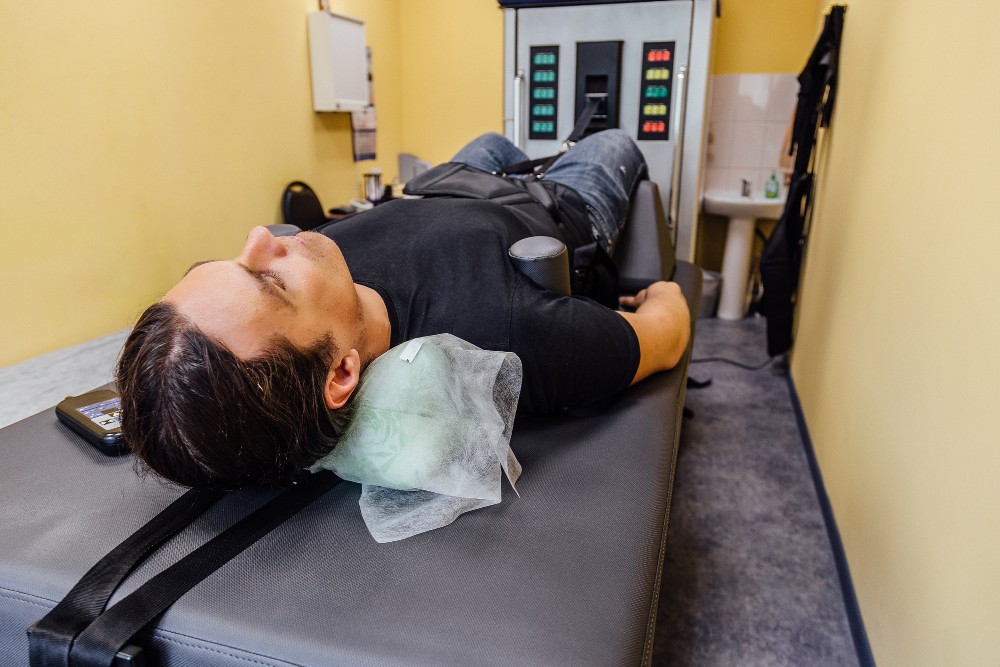How Spinal Decompression Therapy is a Game-Changer for Back Pain
Are you struggling with persistent back or neck pain that just won’t go away? Spinal decompression therapy, a cornerstone of modern chiropractic care, offers a non-surgical solution to relieve discomfort in your spinal column caused by conditions such as disc herniation and sciatica. In this blog post, we’ll explore how this innovative therapy can alleviate pain, restore mobility, and significantly improve your quality of life.
What is Spinal Decompression Therapy?
Spinal decompression therapy is a non-surgical treatment option for individuals experiencing chronic back pain, typically caused by herniated discs, spinal stenosis, or other degenerative disc diseases. This therapy, performed by a chiropractor, involves stretching the spine using a traction table or similar motorized device, with the aim of relieving pain and promoting an optimal healing environment for bulging, degenerating, or herniated discs. By creating negative pressure in the disc, non-surgical spinal decompression can help reduce pressure on the spinal nerves and enhance the movement of water, oxygen, and nutrient-rich fluids into the discs so they can heal.
What are the Benefits of Spinal Decompression Therapy?

Spinal decompression therapy offers a range of benefits for individuals suffering from various back and neck conditions. Here’s a comprehensive list of the advantages this therapy provides:
- Pain Relief: One of the primary benefits of spinal decompression therapy is significant pain relief, especially for those suffering from conditions caused by pressure on spinal nerves, such as herniated discs and sciatica. By reducing this pressure, the therapy can alleviate pain and improve quality of life.
- Non-Invasive Treatment: Spinal decompression is a non-surgical option that avoids the risks and extended recovery time associated with invasive procedures. This makes it an attractive choice for patients seeking alternatives to surgery.
- Reduction in Nerve Compression: The therapy effectively stretches the spine and creates negative pressure within the disc. This process helps retract herniated or bulging disc material, thereby reducing compression on nerve roots and relieving symptoms of nerve impingement.
- Promotes Healing: Decompression therapy enhances blood flow to the affected area, which increases the delivery of oxygen and nutrients. This improved circulation helps heal damaged discs and reduces degeneration.
- Increases Mobility: By alleviating pain and improving the condition of spinal discs and joints, spinal decompression therapy can enhance flexibility and mobility, enabling patients to perform daily activities with greater ease.
- Prevents Long-Term Complications: Regular treatments can help prevent the progression of spinal conditions and reduce the need for more aggressive interventions like surgery in the future.
- Safe for a Wide Range of Patients: The therapy is suitable for most adults, including those for whom surgery is not recommended due to health issues like diabetes or heart disease.
- Complementary to Other Treatments: Spinal decompression can be integrated with other rehabilitative strategies such as physical therapy, chiropractic adjustments, and pain management programs to enhance recovery.
Overall, spinal decompression therapy is a valuable tool in the management of chronic back and neck conditions, offering a safe, effective, and non-invasive solution that helps patients return to a more active lifestyle.
What Conditions Does Spinal Decompression Therapy Treat?

Spinal decompression therapy is a non-invasive treatment option primarily used to address various musculoskeletal problems related to the spine that cause chronic back and neck pain. This therapy is particularly effective for individuals suffering from conditions that impact the intervertebral discs and spinal nerves. Here’s a detailed look at the types of conditions spinal decompression therapy can treat:
- Herniated Discs: One of the most common conditions treated with spinal decompression is herniated discs. This occurs when the soft, gel-like center of a spinal disc pushes through a crack in the tougher exterior casing. This herniation can compress nearby nerves, leading to pain, numbness, or weakness along the nerve. Decompression therapy helps by creating negative pressure and space, which may encourage the herniated material to retract back into the disc, alleviating pressure on the nerve.
- Degenerative Disc Disease: As people age, their spinal discs can degrade, losing fluid and flexibility, which leads to the discs’ inability to cushion the vertebrae effectively. Spinal decompression therapy can enhance the flow of nutrients and fluids into the discs, promoting healing and reducing the symptoms of degenerative disc disease.
- Sciatica: Sciatica is characterized by pain that radiates along the path of the sciatic nerve, which extends from the lower back down through the hips and buttocks and along each leg. Typically, this pain is caused by compression of the sciatic nerve, often due to a herniated disc or spinal stenosis. Decompression therapy can relieve this nerve compression, significantly reducing sciatic pain.
- Spinal Stenosis: This condition involves the narrowing of spaces within the spine, which can compress the spinal cord and nerves. Spinal decompression therapy helps by enlarging the spinal canal space, thus reducing pressure on the spinal cord and nerve roots.
- Posterior Facet Syndrome: It involves pain due to the wearing down of the facet joints, which help stabilize the spine and limit its motion. Decompression therapy can relieve stress on these joints by repositioning the spine and improving alignment.
- Injured or Diseased Spinal Nerve Roots: Compression or inflammation of spinal nerve roots can cause pain and dysfunction. Decompression therapy aids in alleviating this compression, facilitating better nerve function and healing.
By targeting the mechanical and structural causes of spinal pain, spinal decompression therapy provides a potential solution for those seeking relief without surgical intervention. It offers a compelling treatment option for managing chronic pain and improving the quality of life for those affected by these debilitating conditions.
How is Spinal Decompression Therapy Done by a Chiropractor?

Spinal decompression therapy administered by a chiropractor is a targeted approach designed to alleviate pain and promote healing in the spine, particularly beneficial for patients suffering from herniated discs, degenerative disc disease, or sciatica. This method harnesses the principles of spinal traction, utilizing advanced technology to provide precise, controlled, and gradual decompression of the affected spinal segments.
The key component of spinal decompression therapy is the controlled application of spinal traction. The decompression table is equipped with a computer that is programmed by the chiropractor to apply a specific amount of traction force to the spine. This force gently pulls the spine apart, increasing the intervertebral space and creating negative pressure within the disc. This negative pressure helps in retracting or repositioning the herniated or bulging disc material, leading to a reduction in pressure on the nerves and other structures in the spine. Additionally, this process helps in enhancing the circulation of blood, oxygen, and nutrients to the discs, which promotes healing.
Here is a step-by-step guide to the process of spinal decompression therapy administered by a chiropractor:
- Initial Evaluation: The chiropractor conducts a thorough evaluation, which includes reviewing the patient’s medical history and performing a physical examination. Diagnostic imaging (such as MRI or X-rays) may be used to gain a detailed view of the spinal issues.
- Customized Treatment Planning: Based on the initial assessment, the chiropractor develops a tailored treatment plan that addresses the specific spinal conditions of the patient.
- Preparation for Therapy: The patient is positioned on a specialized decompression table, lying either face up or face down. A harness is secured around the patient’s hips, which is connected to the lower part of the table.
- Setting the Decompression Machine: The chiropractor sets the parameters on the decompression table’s computer, customizing the amount of force and duration of decompression according to the treatment plan.
- Commencement of the Therapy: The decompression table gently separates the spinal vertebrae, creating a vacuum effect within the discs. This process is controlled by the computer to ensure precise force application and timing. This separation helps reduce the pressure on the spinal nerves and discs, encouraging retraction of herniated or bulging discs.
- Cyclic Stretching and Relaxation: The therapy includes cycles of stretching and relaxation, which help to promote the movement of oxygen, water, and nutrients into the discs to aid healing. Each session typically lasts between 15 to 30 minutes, and the stretching-relaxing cycles are repeated several times.
- Monitoring and Adjustments: The chiropractor closely monitors the patient’s response to treatment during each session. Adjustments to the treatment parameters may be made based on the patient’s progress and comfort levels.
- Ongoing Evaluation and Treatment: The number of sessions required varies depending on the patient’s condition and response to the therapy. Regular evaluations are conducted to track progress and adjust the treatment plan as necessary.
- Post-Therapy Care: After completing a course of decompression therapy, the chiropractor may recommend physical therapy, exercises, or lifestyle adjustments to help maintain spinal health and prevent future issues.
- Follow-Up: Follow-up appointments may be scheduled to ensure that the benefits of the therapy are sustained and to address any residual or recurring pain. This guide outlines a structured approach to spinal decompression therapy, emphasizing a patient-centered and data-driven method for achieving relief from lower back pain and promoting spinal health.
How Long Does Spinal Decompression Therapy Last?
The duration and frequency of the sessions vary depending on the individual’s condition and response to treatment. Typically, a session lasts between 15 to 30 minutes, and patients may require multiple sessions over several weeks to see significant improvement. The precise, gentle stretching and relaxing of the spine are repeated multiple times during each session, allowing the spine to adjust gradually without causing pain or discomfort.
Is Spinal Decompression Therapy Painful?
Spinal decompression treatment is not painful. Most patients experience a sense of stretch in their spine, but this is typically not uncomfortable. The therapy is designed to be gentle and controlled, aiming to alleviate pain rather than cause it. Some individuals might feel mild discomfort initially due to the stretching of tight muscles and ligaments. However, any discomfort usually subsides as the body adapts to the treatment. Patients often report a significant difference with pain relief and a sense of relaxation during the sessions. It’s important for patients to communicate with their therapist to adjust the treatment settings if any discomfort arises.
To learn more about how Spinal Decompression Therapy can help you, make an appointment with our Bend chiropractors today.

